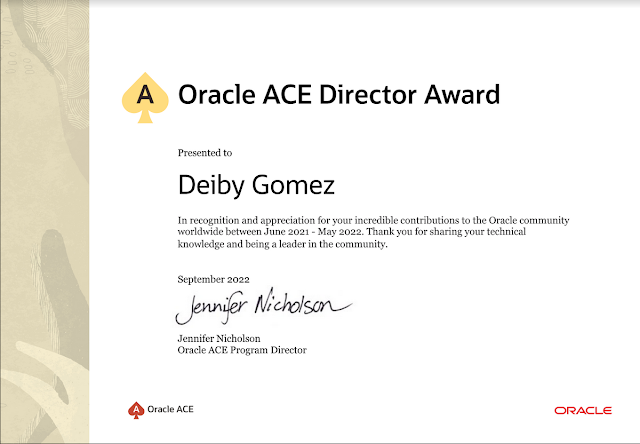In this article I will show how to install Grid Infrastructure Software 19c and how to configure it using silent mode in Oracle Enterprise Linux 8.
Installation-only steps
Unzip the binaries into the GI Home Directory:
$ unzip LINUX.X64_193000_grid_home.zip -d /u01/app/oracle/product/19.0.0/grid_home
$ cd /u01/app/oracle/product/19.0.0/grid_home
$ cp ./inventory/response/grid_install.rsp .
Configuring passwordless between servers:
$ /u01/app/oracle/product/19.0.0/grid_home/deinstall/sshUserSetup.sh -user grid -hosts "srv1 srv2" -noPromptPassphrase -advanced
Creating response file:
$ cat <<EOF > grid_install.rsp
oracle.install.responseFileVersion=/oracle/install/rspfmt_crsinstall_response_schema_v19.0.0
INVENTORY_LOCATION=/u01/app/oracle/product/19.0.0/oraInventory
oracle.install.option=CRS_SWONLY
ORACLE_BASE=/u01/app/oracle/product/19.0.0/grid_base
oracle.install.asm.OSDBA=asmdba
oracle.install.asm.OSOPER=asmoper
oracle.install.asm.OSASM=asmadmin
oracle.install.crs.config.scanType=LOCAL_SCAN
oracle.install.crs.config.SCANClientDataFile=
oracle.install.crs.config.gpnp.scanName=scan01
oracle.install.crs.config.gpnp.scanPort=1521
oracle.install.crs.config.ClusterConfiguration=STANDALONE
oracle.install.crs.config.configureAsExtendedCluster=false
oracle.install.crs.config.memberClusterManifestFile=
oracle.install.crs.config.clusterName=cluster01
oracle.install.crs.config.gpnp.configureGNS=false
oracle.install.crs.config.autoConfigureClusterNodeVIP=false
oracle.install.crs.config.gpnp.gnsOption=
oracle.install.crs.config.gpnp.gnsClientDataFile=
oracle.install.crs.config.gpnp.gnsSubDomain=
oracle.install.crs.config.gpnp.gnsVIPAddress=
oracle.install.crs.config.sites=
oracle.install.crs.config.clusterNodes=srv1:srv1-vip,srv2:srv2-vip
oracle.install.crs.config.networkInterfaceList=bond0:192.168.10.0:1,bond1:10.10.50.0:5
oracle.install.crs.configureGIMR=false
oracle.install.asm.configureGIMRDataDG=
EOF
Set the env variable to validate OEL8:
$ export CV_ASSUME_DISTID=OEL8
Install GI Software:
$ /u01/app/oracle/product/19.0.0/grid_home/gridSetup.sh -silent -responseFile /u01/app/oracle/product/19.0.0/grid_home/grid_install.rsp -ignorePrereqFailure
Scripts Post-Installation:
in srv1:
#/u01/app/oracle/product/19.0.0/oraInventory/orainstRoot.sh
in srv2:
#/u01/app/oracle/product/19.0.0/oraInventory/orainstRoot.sh
in srv1:
#/u01/app/oracle/product/19.0.0/grid_home/root.sh
in srv2:
#/u01/app/oracle/product/19.0.0/grid_home/root.shConfiguration steps
Creating response file:
$ cat <<EOF > grid_install.rsp
oracle.install.responseFileVersion=/oracle/install/rspfmt_crsinstall_response_schema_v19.0.0
INVENTORY_LOCATION=/u01/app/oracle/product/19.0.0/oraInventory
oracle.install.option=CRS_CONFIG
ORACLE_BASE=/u01/app/oracle/product/19.0.0/grid_base
oracle.install.asm.OSDBA=asmdba
oracle.install.asm.OSOPER=asmoper
oracle.install.asm.OSASM=asmadmin
oracle.install.crs.config.scanType=LOCAL_SCAN
oracle.install.crs.config.SCANClientDataFile=
oracle.install.crs.config.gpnp.scanName=scan01
oracle.install.crs.config.gpnp.scanPort=1521
oracle.install.crs.config.ClusterConfiguration=STANDALONE
oracle.install.crs.config.configureAsExtendedCluster=false
oracle.install.crs.config.memberClusterManifestFile=
oracle.install.crs.config.clusterName=cluster01
oracle.install.crs.config.gpnp.configureGNS=false
oracle.install.crs.config.autoConfigureClusterNodeVIP=false
oracle.install.crs.config.gpnp.gnsOption=
oracle.install.crs.config.gpnp.gnsClientDataFile=
oracle.install.crs.config.gpnp.gnsSubDomain=
oracle.install.crs.config.gpnp.gnsVIPAddress=
oracle.install.crs.config.sites=
oracle.install.crs.config.clusterNodes=srv1:srv1-vip,srv2:srv2-vip
oracle.install.crs.config.networkInterfaceList=bond0:192.168.10.0:1,bond1:10.10.50.0:5
oracle.install.crs.configureGIMR=false
oracle.install.asm.configureGIMRDataDG=
oracle.install.crs.config.storageOption=FLEX_ASM_STORAGE
oracle.install.crs.config.sharedFileSystemStorage.votingDiskLocations=
oracle.install.crs.config.sharedFileSystemStorage.ocrLocations=
oracle.install.crs.config.useIPMI=false
oracle.install.asm.SYSASMPassword=manager1
oracle.install.asm.diskGroup.name=OCR_VOTING
oracle.install.asm.diskGroup.redundancy=EXTERNAL
oracle.install.asm.diskGroup.AUSize=4
oracle.install.asm.diskGroup.FailureGroups=
oracle.install.asm.diskGroup.disks=/dev/oracleasm/disks/OCR
oracle.install.asm.diskGroup.quorumFailureGroupNames=
oracle.install.asm.diskGroup.diskDiscoveryString=/dev/oracleasm/disks/*
oracle.install.asm.monitorPassword=manager1
oracle.install.asm.configureAFD=false
EOF
Set the env variable to validate OEL8:
$ export CV_ASSUME_DISTID=OEL8
Configure GI Software:
$ /u01/app/oracle/product/19.0.0/grid_home/gridSetup.sh -silent -responseFile /u01/app/oracle/product/19.0.0/grid_home/grid_install.rsp -ignorePrereqFailure
Scripts Post-Configuration:
# in srv1: /u01/app/oracle/product/19.0.0/grid_home/root.sh **(wait until complete)
# in srv2: /u01/app/oracle/product/19.0.0/grid_home/root.sh
as grid:
$ in srv1: /u01/app/oracle/product/19.0.0/grid_home/gridSetup.sh -executeConfigTools -responseFile /u01/app/oracle/product/19.0.0/grid_home/grid_install.rsp -silent



